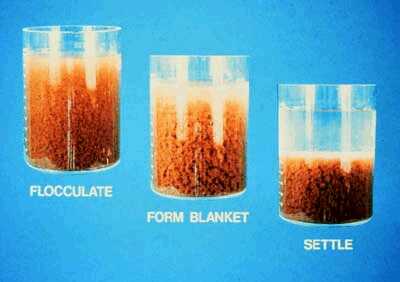- Fill your settleometer with 25 - 50% MLSS taken from the aeration basin. Make sure you mix the sample first to ensure you have solids all suspended.
- Use effluent or tap water to fill the settleometer. Again mix the MLSS/Water blend to suspend the solids.
- Start 30 minute timer. Note sludge level at time 5, 10, 15, 20, 25, & 30. Adjust dilution to have SV30 settled solids reading between 150 - 300 ml on the settleometer. After settling, note floating solids and pin-floc in the supernatant. You should also let the solids continue to compact for 2 - 4 hours. Evaluating the compacting solids gives information about how concentrated the RAS solids will become in the secondary clarifier.
- For reporting purposes and SVI calculations, remember to multiply by your dilution factor.
|
When you have MLSS above 5,000 mg/L, SV30 tests often have solids with a very narrow band of supernatant. This can make it difficult to diagnose problems with pin floc, settling velocity, and compaction. If you see the water phase of less than 20% of the settleometer, the diluted SV30 test may prove useful. Here is how to run a diluted SV30:
Frederik Wynants
2/21/2020 12:04:52 am
When i run al diluted SV30 i get straggler flocs in the supernatant. The more i dillute the more stragglers. What does that mean ? Initial MLSS concentration is around 3700 mg/L. By straggler flocs i mean relative big but fluffy, light macroflocs. Comments are closed.
|
AuthorErik Rumbaugh has been involved in biological waste treatment for over 20 years. He has worked with industrial and municipal wastewater facilities to ensure optimal performance of their treatment systems. He is a founder of Aster Bio (www.asterbio.com) specializing in biological waste treatment. Click to set custom HTML
Archives
April 2024
|


 RSS Feed
RSS Feed